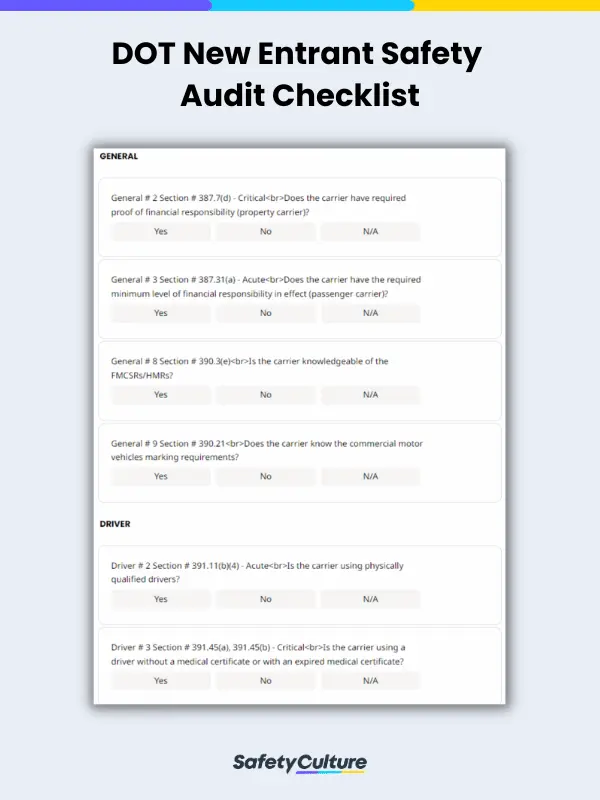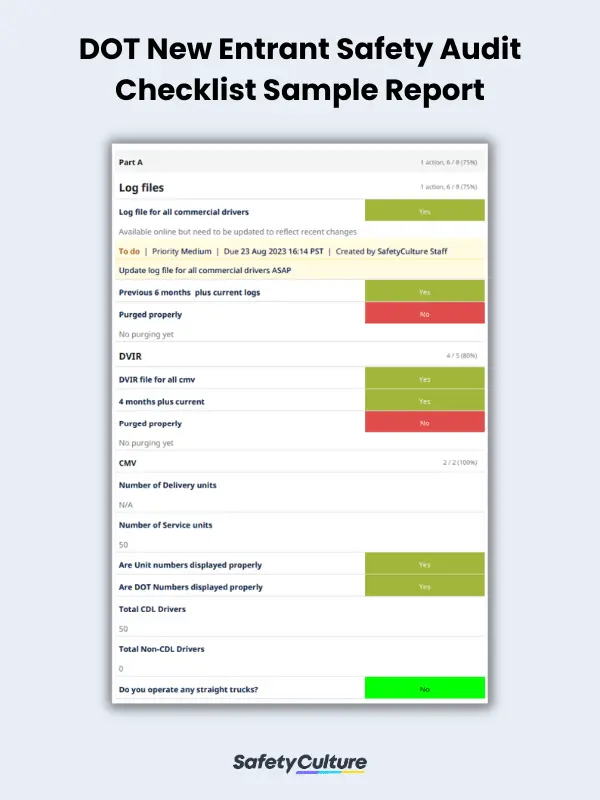What is a DOT New Entrant Safety Audit Checklist?
A DOT new entrant safety audit checklist is a document required by the US Department of Transportation (DOT) that new commercial fleets and transportation services need to fill out before entering the US market. It details the safety procedures and standards fleet managers and drivers need to adhere to, as well as the possible risks they need to address on the job.
Importance
The primary purpose of a DOT new entrant safety audit checklist is to ensure new fleets and other commercial transportation service providers in the US and Canada are safe and compliant with safety standards to operate. It also introduces them to how the US DOT works. During this process, designated safety and DOT officials will examine your safety records, business records, processes, and procedures. This meticulous evaluation encompasses many components, spanning vehicles, drivers, and operational practices.
However, as this is a long process, having a dedicated checklist for the cause is considered essential and a big help in streamlining the safety audit process for both inspectors and service providers. It serves as a comprehensive blueprint for carriers striving to achieve and maintain regulatory compliance, as well as a way to ensure safety at all times, even when you are already in operation.
What Triggers a DOT New Entrant Safety Audit?
New commercial transportation operators and service providers are required to conduct a DOT new entrant safety audit within 120 days of initial operations for passenger carriers and within 12 months for all other kinds of services. This can happen anytime during the first year of operation, and it shall be held in the transport service providers’ headquarters, with the right DOT personnel coming over to conduct their safety audits.
The following are to be inspected:
- Vehicle conditions and if they meet federal requirements
- Driver working conditions and mental capacity to make sound decisions on the road
- Vehicles’ and operator’s service and repair reports
- Compliance with other regulations as necessary, such as Household Goods (HHG) Regulations and the Americans with Disabilities Act (ADA)
What to Include
Following the list of what needs to be inspected of new fleets and transport service providers to the US DOT, your DOT new entrant safety audit checklist should include fields for the following:
- Information about your vehicle or vehicles
- Assessor’s details
- Status of vehicles and current drivers
- Driver Vehicle Inspection Report (DVIR) status
- Number of Commercial Motor Vehicles (CMV)
- Driver information and statistics
- Status of trucks, tractors, and trailers, if applicable
- Total number of inspections
- Recordable incidents or accidents, if any
- Review of the financial capability of the operator to operate
- Medical review of drivers and their capabilities to work
- Maintenance schedule and procedures
- Signatures of involved personnel
Here is a sample digital DOT new entrant safety audit checklist in use for reference:
FAQs about DOT New Entrant Safety Audit Checklists
There are two major parties to a DOT new entrant safety audit. First is the motor carrier or transport service provider in its entirety, which includes managers, drivers, mechanics, and other staff. The other party is a federal safety investigator and, in some situations, a state or provincial enforcement officer.
As a DOT new entrant safety audit checklist is based on DOT standards, it can be repurposed for other CMV needs, such as:
- Addressing transportation violations
- Performing interventions based on noncompliance
- Conducting maintenance inspections
Failing the DOT new entrant safety audit can happen for different reasons, such as having medically unfit drivers, operating unsafe vehicles, and more. Failing the new entrant safety audit can lead to fines, penalties, suspension of operations, and, in worst-case scenarios, corrective actions from certain safety or government agencies. However, you can always request a re-audit after improving your operations as needed.




